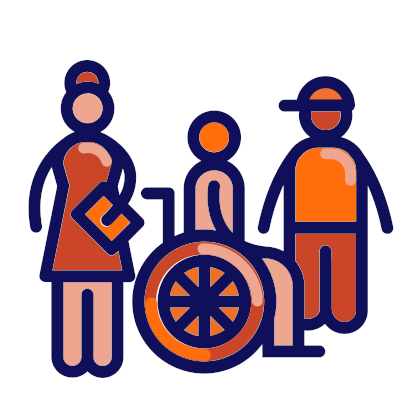Preventing bullying and violence

Schools can, and should, play a key role in tackling these abuses.
Whole-school anti-bullying programmes are needed, which promote peer support systems and involve active and well-trained teachers and parents, to foster a safe learning environment in which no violence is allowed.
Facts & figures
Half of the world’s students aged 13-15 say they have experienced violence in and around school.[1]
Nearly one in three students of this age say they have experienced bullying or been involved in fights.[2]
More than 700 million children have no legal protection from corporal punishment at school.[3]
What is violence and bullying?
Violence is the threatened or actual use of physical force or power resulting in physical or psychological harm to others.
Bullying is a form of violence. It can be defined as unwanted, aggressive behaviour which involves a real or perceived imbalance of power. It is behaviour that is repeated, or carries the threat of being repeated over time.
Bullying takes different forms in school, including:
- Physical, e.g., hitting, kicking, slapping, shoving, hair-pulling, etc.
- Verbal, e.g., name-calling, teasing, using belittling expressions, etc.
- Relational, e.g., ostracising, spreading rumours, social manipulation, etc.
- Sexual, e.g., sexual name-calling, uninvited touching, propositioning, etc.
Cyberbullying is a distinctive form of bullying. It differs from other types on account of the constant risk of public exposure, the complex roles of observers and the size of the audience that comes with digital technologies.[4].
Bullying is not the only form of student-on-student violence in schools, however. Fights between, and attacks on students associated with gang culture and the carrying of weapons, especially knives, are becoming an increasing problem in various countries.
Why is addressing violence and bullying important at school?
Under the U.N. Convention on the Rights of the Child, schools have a formal duty to protect children from all forms of violence, both physical and psychological.
“Parties shall take all appropriate legislative, administrative, social and educational measures to protect the child from all forms of physical or mental violence, injury or abuse, neglect or negligent treatment, maltreatment or exploitation, including sexual abuse, while in the care of parent(s), legal guardian(s) or any other person who has the care of the child.”[5]
Failure to protect children at school can have harmful repercussions on their future lives, both educationally and socially - whether they be victims, perpetrators or bystanders.
Students who are bullied are more likely to suffer from depression and anxiety, health issues, poor academic achievement and behaviour problems at school, including higher drop-out rates. A small number may also retaliate in violent ways. Students who bully others are more likely to exhibit other behaviour problems at school and to suffer from alcohol or drug abuse, and to engage in criminal activity and abusive relationships in adulthood. Children who witness bullying and violence are also more likely to have mental health difficulties and miss or drop out from school.
Violence and bullying not only affects academic learning, it also impacts negatively on the social development of young people. In particular, students who experience violence and bullying are more likely to have difficulty developing basic democratic competences, such as empathy, respect for others, openness to other cultures and beliefs, tolerance of ambiguity and self-efficacy – all of which lie at the heart of the Council of Europe Reference Framework of Competences for Democratic Culture.
The effects of violence and bullying are not limited only to the students directly involved, but potentially impact on everyone at a school. Unchecked, incidents of violence and bullying lead to an atmosphere of anxiety and insecurity incompatible with learning. They also lead to, or exacerbate conflicts beyond the school gates, which in turn have further consequences for relations within the school.
What are the challenges?
Violence and bullying can be challenging to deal with at school. What is regarded as bullying or violence is sometimes thought of as a matter of subjective opinion. It can be difficult to build a common approach to eradicating from school something which a significant proportion of staff believes not to exist or is not important to them.
The prevailing culture in a school can sometimes work against attempts to reduce violence in its different forms. Rule by fear, over-emphasis on punishment and the prioritization of learning environments which support competitive behaviour all militate against the prevention of violence and bullying. So, too, does the holding of an ideology which accepts violence as a valid response in situations of fear, stress or frustration – as evidenced in the advice commonly given to victims of bullying to fight back and give the bully a ‘taste of their own medicine.’
In such circumstances it can be easy to think that dealing with violence and bullying is simply a matter of stopping fights, giving punishments and imposing order, rather than questioning the wider culture of the school, the examples it sets and the sorts of behaviour it supports.
Many teachers are unaware of democratic approaches of dealing with violence and bullying, such as:
- restorative justice
- conflict resolution
- peer mediation.
Such approaches are not only arguably more effective than punitive ones, but also have the advantage of promoting democratic values and attitudes more widely across a school.
Such approaches take time to learn, however, and require the development of specific types of skills, knowledge and attitudes. They also take time to put into practice. It can be difficult for a teacher to find the time and motivation to deal with violence and bullying in a democratic and constructive way. It is easier just to punish the supposed perpetrator, and easier still to pass the perpetrator up the school hierarchy for a more senior member of staff to punish.
A further challenge in recent years has been the rise of gang culture among young people and the carrying of weapons, especially knives, in as well as out of school. This has led to a rise in the number of serious acts of violence between students and also to the more regular involvement of the police in school affairs, both of which demand new professional skills and ways of working from teachers and school leaders.
How can schools get active?
Taking action on violence and bullying is not just a matter of finding better ways of responding to incidents after they have occurred – though this is important, but also of creating the kind of school environment in which violent incidents are less likely to happen in the first place.
A good place to start is with asking students to review the current situation in their school:
- where they feel vulnerable or in danger
- where they feel safe
- what sorts of violence they have witnessed or experienced
- what they see as the causes of these sorts of violence
- how effective they think the school is at dealing with violence
- what further measures they would like the school to take.
Surveying student opinion provides a good evidence base for targeting measures to prevent violence, e.g., increasing supervision in areas in school where students are fearful of going, creating more opportunities for constructive play during breaks from lessons, etc.
It can also stimulate a whole-school conversation about violence and bullying. Such a conversation is important for arriving at a whole-school policy that everyone can support. It is an opportunity to develop a common language and understanding of what constitutes violence and bullying in school and shared rules on how to approach it, including the reporting and monitoring of incidents. This is why it is essential that the voices of all school stakeholders are heard in the process of policy-development: principals, teachers, students, parents and the local community.
The conversation should also include the opportunity for teachers to reflect on practices that lead to frustration and low self-esteem among students, such as an over-emphasis on competition, over-frequent assessment and unreasonably high expectations of academic attainment. Attention should be given instead to creating a school environment which encourages inclusion and co-operation, and the valuing of individual differences and diversity.
Reflection on current practice goes hand in hand with the provision of opportunities for school staff to develop new skills. The ability to recognise violence in all its forms and to be able to deal with it appropriately are important professional skills for any adult involved in school life.
As young people themselves are often the most effective agents for change in a school, it is important they should be involved in formal initiatives to reduce violence and bullying, such as peer mediation schemes. Such schemes are most effective when taken seriously by both staff and the students involved, for example, by instituting formal recruitment procedures for student mediators and opportunities for high-level training from someone with the appropriate professional expertise.
Initiatives of this kind can be supported in the classroom by making time in the curriculum to talk with students about issues of violence and bullying. It should include discussions about the psychology of bullying, the effects of peer pressure and the influence of social media on young people’s behaviour.
[1] UNICEF Report, September 2018
[4] de Morais & Fernandes, 2017. ‘When bullying crossleakes the screen’. In J. Richardson, E. Milovidov & R. Blamire (Eds.), Bullying: Perspectives, Practices and Insights (pp. 11-16). Strasbourg, France: Council of Europe.
 Resources on Preventing violence and bullying
Resources on Preventing violence and bullying
 Related schools projects
Related schools projects
Address: Kocagur Street Number:1 Efeler/Aydin
Country: Turkey
Project: Give a Hand Be a Light
 Working language during the project:
Working language during the project:
- English
- Turkish
 Themes of the Council of Europe campaign “FREE to SPEAK, SAFE to LEARN - Democratic Schools for All” covered:
Themes of the Council of Europe campaign “FREE to SPEAK, SAFE to LEARN - Democratic Schools for All” covered:
- Making children’s and students’ voices heard
- Addressing controversial issues
- Preventing violence and bullying
- Tackling discrimination
- Improving well-being at school
 Competences from the Reference Framework of Competences for Democratic Culture (CDC) addressed and where / how they were integrated:
Competences from the Reference Framework of Competences for Democratic Culture (CDC) addressed and where / how they were integrated:
- Flexibility and adaptability
A Flower and seedling cultivation project, which also matched their lifestyle, was started to provide them with the economic opportunities which are given to the other members of the society. We got in contact with employers in the sector to provide flexibility and to adopt the working rules in different working areas. - Knowledge and critical understanding of the world: politics, law, human rights, culture, cultures, religions, history, media, economies, environment, sustainability
As our students come from different cultures, they have problems in adopting the community rules. We invited a variety of social groups to our school to provide cultural communication. We aim to raise environmental awareness and love of nature by activities such as hiking, picnics, visiting animal shelters. - Co-operation skills
Culturally, they are used to living alone. They find it difficult to work in groups. A variety of social, cultural, artistic and sportive activities are done together (making model airplanes, football tournaments, choir, drama etc.).
 Target group age range:
Target group age range:
- 5-11
- 11-15
 Level of education:
Level of education:
- Primary education
- Lower secondary education
Short description of the project:
Our school is in Aydin, in the west part of Turkey. Originally Kocagur neighbourhood was a village and people still continue to live in a village style. More than half of the population are Roma. They have economic, medical, educational and unemployment problems. The rate of crime and drug addiction is high. In our school we have 88 students and 12 teachers. Our school is located in a disadvantaged area. For this reason, it is difficult to have healthy communication as leaving school at an early age and cultural differences are so common. Absenteeism and school leaving is higher than average, both provincially and nationally.
Furthermore, the absence rate in the lower secondary school in Aydın is 35%, but in our school the rate is 67%. Those who are continually absent will not get to go to the upper class and drop out of school. Our aim is to prevent these bad habits and use different approaches and methods to make these pupils regularly participate in school life. Among our approaches are home visits and cooperating with the families. We have organised school trips but these had little success. Then we informed the public authorities, and the authorities decided to monitor the families. Within ASDEP (Family Social Support Project), which includes all school teachers, every family has been monitored with regard to their economic, health and social conditions. In the meantime, the absenteeism rate has decreased but not ceased.
A variety of professionals and amateurs visit the school, such as natural disaster specialists, amateur music groups, university students, non-governmental organizations. They all give examples of difficulties they faced throughout their lives and encourage the students to overcome the obstacles they may face. They have fun and learn together.
We, as students, teachers and parents, visit and join a variety of cultural, historical, artistic and sportive activities. In-class and in-school activities are co-organised, such as painting, dramas and sports tournaments that give support to increasing students’ hand, artistic and sporting skills.
 Aims/objectives
Aims/objectives
- to inform the families about the importance of education
- to make the students love the school
- to make the school their life style
- to improve their language and communication skills
- to increase their tolerance of multicultural lifestyles
- to stop school absenteeism and early-school-leaving
- to encourage them to adapt to different cultural communities and community lifestyle and rules
 Expected results/outcomes
Expected results/outcomes
- Role models from the fields of art, sports and culture, role-models for our students
- Students are able to recognise the historical and cultural wealth of our country, and thus adopt new public rules and protect the environment.
- Students find work according to their skills and interests and have no difficulty regarding access to upper education.
 Changes
Changes
- Particularly with the role models whom our students take as an example, we have realised that our students change their behaviours and lifestyles as they aspire to these role-models. With a variety of trips, we get our students familiar with our cultural and historical values. Also, they communicate with different cultures and adopt public rules to a large extent.
- Thanks to project’s activities, students mostly decide to get jobs in line with their interests and skills.
- As they take more active roles in the society, they have more self-esteem.
 Challenges you faced
Challenges you faced
- Societal prejudice because of our students’ cultural background.
- Issues arising from students’ material and non-material problems.
- Parents’ negative attitudes and behaviours towards students, school and education.
- The negative effect of the environmental and physical conditions.
 Time-frame of the project:
Time-frame of the project:
- 1.10.2018 - 2.08.2021
 Council of Europe materials on citizenship and human rights education used while preparing or implementing your practice:
Council of Europe materials on citizenship and human rights education used while preparing or implementing your practice:
- Reference Framework of Competences for Democratic Culture







